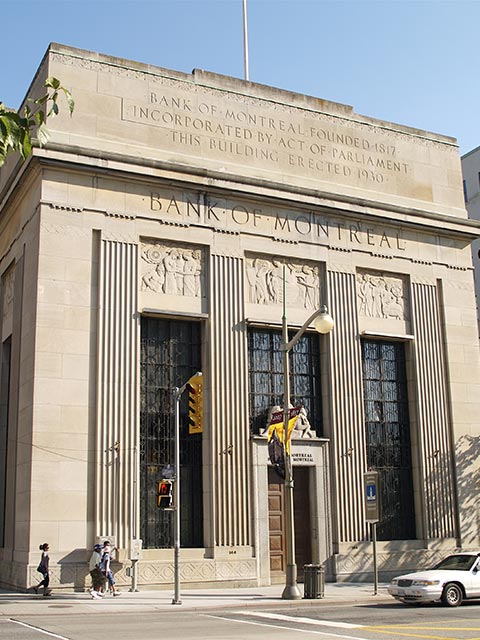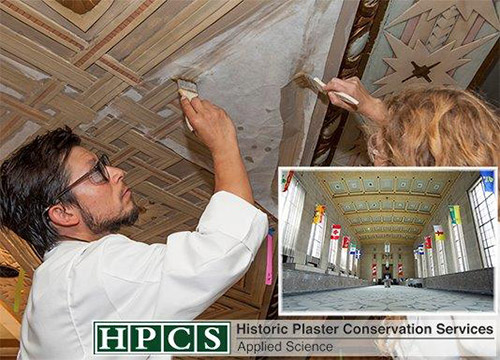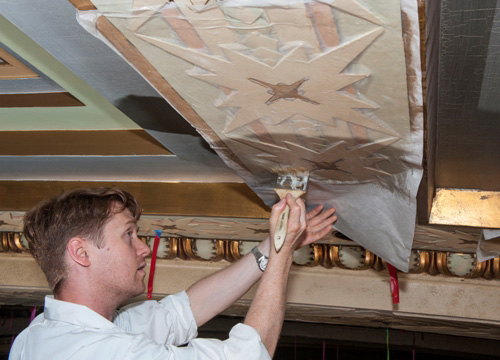Formerly the Bank of Montreal, Ottawa, Ontario (1930)
The Building:
An example of Beaux-Arts architecture, reflecting several styles that have long been used to design Canadian banks. The building was shut down in 2005 to undergo a significant multi-phase rehabilitation project that was completed in 2016.
TRI Funori™ – Ideal for Cleaning Delicate Paint:
As the plaster conservator for the rehabilitation project, Historic Plaster Conservations Services conducted an evaluation of the plaster throughout the building.
This evaluation revealed that the ceiling surface in the Main Hall was covered by an oily soiling that had to be removed as a first step in the ceiling’s rehabilitation. This was a particularly challenging task due to the delicate paint finish. After a successful demonstration, the client, represented by architects, agreed to the use of a new HPCS product, TRI Funori™, a natural, non-toxic and non-hazardous liquid containing a polysaccharide extracted from Japanese seaweed. Funori has been used in many Japanese craft processes for centuries. As a cleaning agent, TRI Funori™ is used with washi (Japanese rice paper). The washi is held in place and the TRI Funori™ is gently brushed through it onto the soiled surface.
A New Product to Treat Fibrous Plaster – RE Aramid Gel™
A structural assessment from the attic side of the ceiling revealed a typical fibrous plaster panel system, with panels fastened to a steel frame. The panels had been manufactured off-site with their own individual metal frames attached. At the site, the panels had been hoisted into place and tied with various gauges of wire to the metal grid that is suspended from the trusses.
During the manufacturing process, the fibrous plaster panels, measuring between 3/8” and 5/8” in thickness, had been reinforced with jute fiber in the form of hessian, a coarse fabric woven for this purpose. The plaster was then connected to the metal frame by more wads of plaster-soaked jute wrapped over the frame and connecting to the plaster. The actual attachment of the ceiling panel therefore depends on the quality of the jute and plaster of Paris that makes up these adhesive wads.
As a result, and as the inspection revealed, the entire mass of cast plaster in the ceiling is suspended by jute twine. There is no metal armature within the matrix of the plaster.
It is well documented that as a natural combustible fibre, jute is highly prone to deterioration from dampness and desiccation over time. In addition, the inspection revealed that many of the panels were cracked.
HPCS inspects a lot of ceiling plaster. We started to notice back in the mid 1990s that many of the ceilings we were looking at were fibrous plaster panels of this type, and that there were no recognized treatment protocols for them similar to the methods and materials we had already developed for wood lath and plaster ceilings. This began a research & development process that brought our HPCS RE Aramid Gel™ fibrous plaster reinforcement product to the market in time for it to be adopted and used at the Sir John A. Macdonald Building rehabilitation project in 2012.
The ceiling evaluation concluded that the cracked and damaged fibrous plaster panels needed to be reinforced, and more significantly that all the connections between the panels and the metal frame of the building needed substantial improvement.
Following a successful field test involving the application RE Aramid Gel™ on a number of the fibrous plaster panels, approval was given by the lead contractor (Ellis Don) and the project architects (Norr Limited and MTBA & Associates) to reinforce the entire the Main Hall ceiling with RE Aramid Gel™. HPCS designed the treatment program and supervised its execution by a contractor.
Based on the success of the cleaning and reinforcement programs, a second ceiling and several other smaller coffered ceilings with more elaborate finishes underwent the same procedures.
In addition, HPCS retained Jablonski Conservation Services as sub-consultants to address the conservation of delicate gilt and painted finishes on all the ceilings.
The multi award-winning project was completed in 2016.



